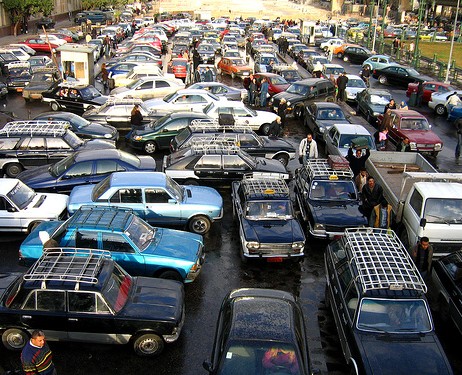The Energy & Traffic Riddle in Egypt
The blog was originally written for National Geographic as part of the Energy Diet initiative. I was asked to keep a blog for a few weeks about my attempts to minimize my carbon footprint. It was rather challenging to do especially that during part of it I was climbing Aconcagua, the highest mountain in Latin America, solo.
Cairo, or the ‘city victorious’ as it translates in Arabic, is a sprawling metropolis full of charm, character — and cars! There are simply too many of them. The vast numbers are even more shocking when one realizes that car penetration is less than 10 percent. I read an automotive report in 2008 that predicted double-digit growth for car sales in the next few years.
Consumption will slow down post-revolution, but this is still a real long-term concern. How much worse can it get? A recent Japanese report predicted that average speed in the capital will go down to 0 kilometers per hour in less than a decade. There are a host of reasons for that, including overpopulation and an inefficient infrastructure, but I think energy policy also deserves a closer look.
I am no expert, but I have to admit I’ve always seen the energy situation in Egypt as quite bizarre. The government has always placed an extremely high subsidy on domestic fossil fuel purchases like petrol, making it cheap (about 30 cents a liter for unleaded petrol compared to $2 a liter in the UK!!) to run our vehicles (I can’t complain!) but at the same time, this offers us almost no incentive to save.
The even bigger concern, in my view, is this has been going on for so long that I doubt most of us even realize that there is a subsidy at all, but rather think this is the market rate for fuel. With Egypt at risk of having to import oil for the first time due to excessive energy use, these policies beg to be re-visited.
However, the solution obviously is not as simple as recalibrating prices. Multiplying the prices sixfold overnight could prove catastrophic. A phased increase makes more sense, but would take years and is merely treating the symptoms.
In my view, a revamp of public transport should be the primary target. In Cairo, the underground trains and buses are dilapidated and the system to use them unintuitive. I lived in London for seven years and never bought a car; here, it is hard to live without one.
If we direct investment over the next five years to improving these facilities, and therefore making it accessible to a bigger segment of the population and across the country as a whole, then we have won half the battle. From here we can direct our attention to infrastructure and policy, and then we may be finally able to tip the scales in our favor in this energy conundrum. I’m optimistic.
over the next five years to improving these facilities, and therefore making it accessible to a bigger segment of the population and across the country as a whole, then we have won half the battle. From here we can direct our attention to infrastructure and policy, and then we may be finally able to tip the scales in our favor in this energy conundrum. I’m optimistic.









